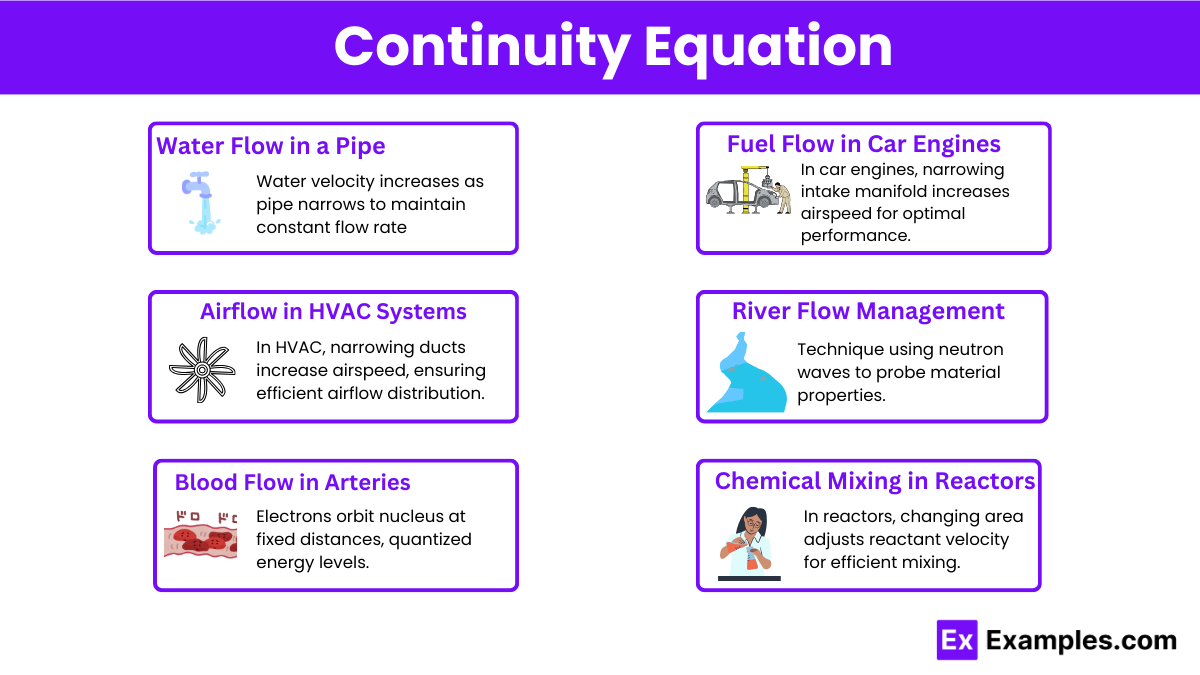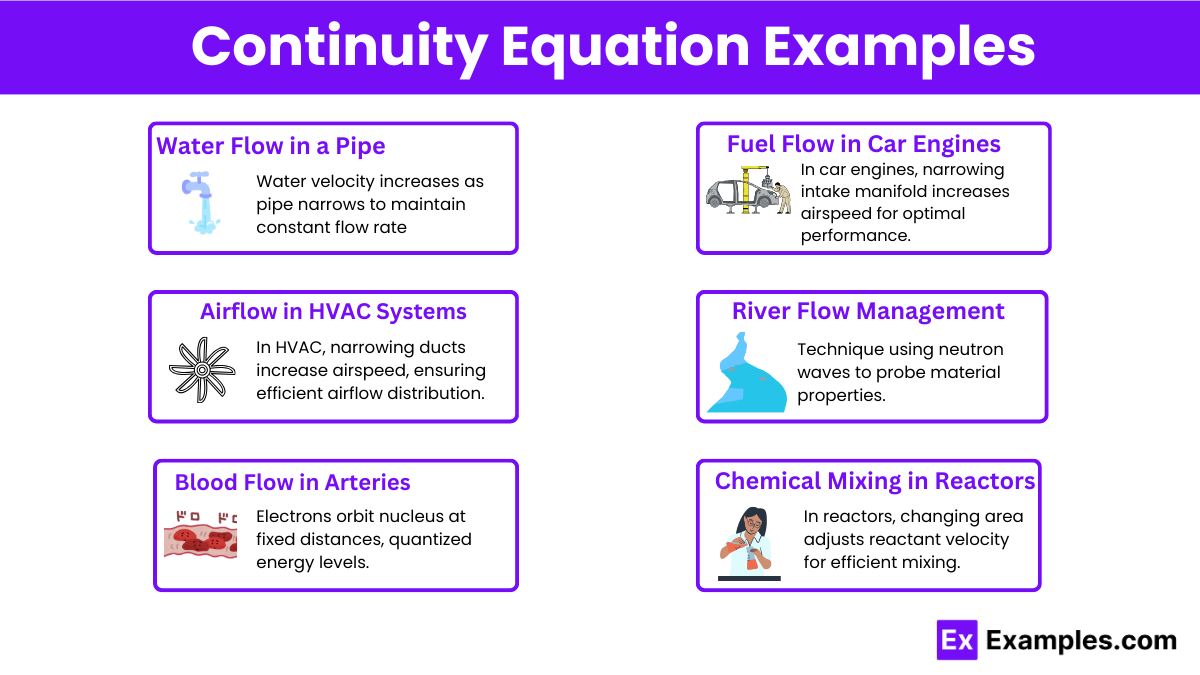In fluid dynamics, what does the continuity equation ensure about fluid flow?
The fluid speed remains constant.
The mass flow rate remains constant.
The pressure remains constant.
The temperature remains constant.


The continuity equation is a fundamental principle in fluid mechanics, expressing the conservation of mass in a fluid system. It states that the rate at which mass enters a system is equal to the rate at which it leaves, ensuring mass is neither created nor destroyed. Mathematically, for an incompressible fluid, it is represented as ( A₁V₁ = A₂V₂ ), where ( A ) is the cross-sectional area and ( v ) is the fluid velocity. This equation is crucial for analyzing fluid flow in various applications, from pipelines to air ducts, ensuring efficient and predictable fluid transport.
The continuity equation is a mathematical expression of the conservation of mass principle in fluid dynamics. It states that for any incompressible fluid, the mass flow rate must remain constant from one cross-section of a pipe or channel to another. In its simplest form for an incompressible fluid, it is written as:
( A₁v₁ = A₂v₂ )
where ( A₁ ) and ( A₂ ) are the cross-sectional areas of the fluid at points 1 and 2, respectively, and ( v₁ ) and ( v₂ ) are the fluid velocities at these points. For a compressible fluid, the equation is more complex and accounts for changes in fluid density:
∂t/∂ρ + ∇ ⋅ (ρv)=0
where ( p ) is the fluid density, ( t ) is time, and ( v ) is the velocity vector field of the fluid. The continuity equation ensures that mass is neither created nor destroyed within the flow system.
The continuity principle, also known as the principle of mass conservation, is a fundamental concept in fluid dynamics that states the mass of fluid entering a system must equal the mass of fluid leaving the system, provided there is no accumulation of mass within the system. This principle ensures that mass is conserved over time within a fluid flow.
For an incompressible fluid, the principle can be expressed using the continuity equation:
[ A₁ V₁ = A₂ V₂ ]
where:
This equation indicates that if the cross-sectional area of the flow decreases, the fluid velocity must increase, and vice versa, to maintain a constant mass flow rate.
For a compressible fluid, the continuity principle is expressed as:
∂t/∂ρ + ∇ ⋅ (ρv)=0
where:
The continuity principle is crucial in engineering and physics for designing and analyzing systems involving fluid flow, such as pipelines, air ducts, and natural streams.
The integral form of the continuity equation is a way to express the conservation of mass for a fluid within a given region. Think of it as ensuring that the amount of fluid inside a balloon stays constant unless it flows in or out through the balloon’s surface.
Here’s the simplified idea:
The continuity equation says that the rate at which the mass inside the volume changes plus the rate at which mass is flowing out must equal zero. In simple terms, this means:
Mathematically, this is written as:
d/dt∫VρdV+∫Sρv⋅ndA=0
where:
For an incompressible fluid (where density ρ is constant), this simplifies to saying that the fluid entering and leaving the control volume must be equal, ensuring mass is conserved.
The basic formula for flow rate (𝑄Q) is:
𝑄=𝐴×𝑣Q=A×v
where:
Fluid dynamics is the study of how fluids (liquids and gases) move and the forces acting on them. It encompasses concepts like laminar and turbulent flow, the continuity equation for mass conservation, and Bernoulli’s principle for pressure and velocity relationships. Navier-Stokes equations describe the motion of viscous fluids, and the Reynolds number predicts flow regimes. Applications include designing aircraft, pipelines, weather forecasting, and understanding ocean currents and blood flow. Fluid dynamics is crucial in engineering, meteorology, oceanography, and medicine for optimizing systems and predicting fluid behavior.
Engineering : The continuity equation is essential in designing pipelines and hydraulic systems, ensuring consistent fluid flow rates and optimizing efficiency for water, oil, gas, and hydraulic devices like lifts and brakes.
Aerospace : In aerospace, the continuity equation aids in designing aircraft wings and airfoils for smooth airflow, optimizing lift and fuel efficiency, and ensuring proper flow rates in rocket propulsion systems.
Environmental Science : The continuity equation is used to predict and manage water flow in rivers and streams, aiding in flood prevention, habitat conservation, and monitoring pollutant spread in water bodies and the atmosphere.
Medical Field : In the medical field, the continuity equation analyzes blood flow in arteries and veins for diagnosing cardiovascular diseases and ensures consistent airflow in respiratory devices like ventilators.
Industrial Processes : Chemical plants use the continuity equation to manage fluid flow in reactors and pipelines, ensuring proper mixing and reaction rates, while cooling systems in power plants and refrigeration units optimize coolant flow.
Construction and Infrastructure : The continuity equation is crucial for designing efficient drainage and sewage systems to handle varying water flow rates and for ensuring uniform water distribution in agricultural irrigation systems.
Automotive Engineering : In automotive engineering, the continuity equation maintains consistent fuel and air flow in internal combustion engines for optimal performance and efficiency and manages coolant flow to prevent engine overheating.
Maritime Engineering : Maritime engineering uses the continuity equation to ensure stable fluid flow around ship hulls for better maneuverability and fuel efficiency, and to maintain consistent internal and external fluid flow for submarine operations.

Water Flow in a Pipe : Consider water flowing through a pipe that narrows from a larger diameter to a smaller diameter. The continuity equation ensures that the flow rate remains constant. As the pipe narrows, the velocity of the water increases to maintain the same flow rate, illustrating how the cross-sectional area and velocity are inversely related.
Airflow in HVAC Systems : In HVAC systems, the continuity equation helps design ducts and vents to ensure consistent airflow throughout a building. For example, if a duct narrows, the airspeed increases to maintain the same volume of air, ensuring efficient heating and cooling distribution.
Blood Flow in Arteries : The continuity equation applies to blood flow in the human body. As blood vessels branch into smaller arteries, the velocity of the blood must increase to maintain a constant flow rate. This principle helps in understanding and diagnosing various cardiovascular conditions.
Fuel Flow in Car Engines : In car engines, the continuity equation ensures that the fuel-air mixture flows consistently through the engine’s intake manifold. As the manifold narrows, the airspeed increases, ensuring proper mixing and combustion for optimal engine performance.
River Flow Management : In river management, the continuity equation predicts how changes in the riverbed affect water flow. If a river narrows, the water velocity increases to maintain the same flow rate, helping manage flood risks and water distribution for agriculture.
Chemical Mixing in Reactors : In chemical reactors, the continuity equation ensures that reactants flow consistently through the reactor. As the cross-sectional area of the reactor changes, the velocity of the reactants adjusts to maintain a constant flow rate, ensuring efficient mixing and reaction rates.
Oil Transport in Pipelines : For oil transport, the continuity equation is crucial in designing pipelines. When the pipeline diameter decreases, the oil flow velocity must increase to maintain a steady flow rate, ensuring efficient transport from production sites to refineries.
Cooling Systems in Electronics : In cooling systems for electronics, the continuity equation ensures that coolant flows consistently through narrow channels. As the channels narrow, the coolant velocity increases, maintaining a constant flow rate to effectively dissipate heat and prevent overheating.
It implies that the product of cross-sectional area and velocity is constant along a streamline.
It helps design systems to ensure consistent fluid flow and avoid bottlenecks.
It ensures that the velocity of blood increases as it moves through narrower vessels to maintain a constant flow rate.
Yes, it applies to both liquids and gases.
It ensures that air flows consistently through ducts, maintaining efficient heating and cooling.
It ensures that fluid flow rates are consistent throughout the pipeline.
The fluid velocity increases to maintain the same flow rate.
Yes, but it requires accounting for changes in fluid density.
It helps design aircraft wings to optimize airflow and maintain efficient lift and fuel consumption.
It ensures that the flow velocity adjusts with changes in pipeline diameter to maintain a steady flow rate.
Text prompt
Add Tone
10 Examples of Public speaking
20 Examples of Gas lighting
In fluid dynamics, what does the continuity equation ensure about fluid flow?
The fluid speed remains constant.
The mass flow rate remains constant.
The pressure remains constant.
The temperature remains constant.
The continuity equation is derived from which principle?
Newton's first law
Bernoulli's principle
Conservation of mass
Conservation of energy
For an incompressible fluid, what is the continuity equation in differential form?
∂ρ/∂t + ∇ · (ρv) = 0
∂ρ/∂t + ∇ · v = 0
∇ · v = 0
∂v/∂t + ∇ · (ρv) = 0
In which situation would you use the continuity equation?
To calculate temperature changes in a fluid
To determine the pressure drop in a pipe
To analyze the flow rate of a fluid through a varying cross-sectional area
To measure the viscosity of a fluid
Which of the following equations is the general form of the continuity equation for a compressible fluid?
∂(ρv)/∂t + ∇ · (ρv) = 0
∂ρ/∂t + ∇ · (ρv) = 0
∇ · v = 0
∂v/∂t + ∇ · v = 0
What is the simplified form of the continuity equation for a steady, incompressible flow?
∂ρ/∂t + ∇ · v = 0
∇ · v = 0
∂v/∂t + ∇ · (ρv) = 0
∂ρ/∂t = 0
What does the continuity equation imply in a pipe with varying diameter?
Velocity increases as the diameter increases.
Pressure increases as the diameter increases.
Velocity decreases as the diameter decreases.
Mass flow rate remains constant.
In a compressible fluid flow, which term in the continuity equation accounts for density changes?
∇ · v
∂ρ/∂t
∂v/∂t
ρv
What does the term ∇ · (ρv) represent in the continuity equation?
Rate of change of density
Mass flux
Rate of change of velocity
Pressure gradient
How does the continuity equation relate to the principle of incompressibility in fluid mechanics?
It states that pressure remains constant.
It states that density is constant and velocity changes with area.
It states that temperature changes with pressure.
It states that the flow rate is constant in compressible fluids.
Before you leave, take our quick quiz to enhance your learning!

